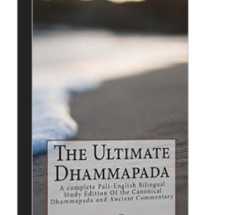 “Tell me, which part of the Tripitaka is the most ancient? Which part would I want to read, study and practice if I look for the most authentic instructions?”
“Tell me, which part of the Tripitaka is the most ancient? Which part would I want to read, study and practice if I look for the most authentic instructions?”
The answer is very simple.
There are two little collections of verses in the entire Pitaka which take up a very unique position. They are kind of tugged away in the mass of teachings but here is what is so special about them:
First of all, they had already been memorized and were cherished by the young Buddhist community during the lifetime of the Buddha. How do we know? Well, there are other ancient suttas in the Tipitaka which refer to these verses as common knowledge amongst lay people and monks during Buddha’s lifetime.
Secondly these two collections are the only ones which have such an ancient commentary attached to them, that that commentary itself is now part of the Tipitaka.
And finally, after a mere 250 years, emperor Ashoka when recommending texts for study selected a few of his recommendations from these collections.
Which are those two?
The “Book of the Eights” (Atthaka-vagga) and the “Book of the Way Beyond” (Parayana-vagga).*
Having set the stage, let us focus on the Parayana Vagga for a second.
It consists of questions and answers between sixteen (young) brahmin priests who all came to see the Buddha.
When we read these verses we can see that some of the terms which would later become standard repertoire of the Buddhist teaching are still in their “infancy”, i.e. we see how the Buddha originally started using them before everyone knew what they meant and they became (Buddhist) technical terminology.
When the sixteen brahmins come to the Buddha “Ajita” starts with very general questions about the world and what might be wrong with it.
But very soon the topic moves into a philosophical/psychological arena.
Ajita wants to know why our minds make us behave like they do and the Buddha responds that that is because of the six streams, i.e. the six sense impressions.
Now Ajita is curious and wonders what one could do about that and the Buddha responds with two tools: sati (“mindfulness”/”remembering”/”witnessing”) and panna (wisdom/knowing).
But Ajita wonders: Isn’t that mental activity as well? How could we ever get beyond all streams? And the Buddha answers, you are right, eventually, what you are looking for is “viññāṇassa nirodhena” ** the extinguishing of the apart-knowing (vi-ñāṇa), generally known and translated as “consciousness”. It is that part of our knowing/consciousness which is able to distinguish (“vi-“, as indicated by the prefix).
Now the next brahmin priest, Tissa-Metteyya takes up the state of such a developed person and wants to know more about the attainment such an “arahant”, i.e. “worthy” person would live in.
Having attained a preliminary understanding of the Buddha’s message we enter round too of their Q&A:
The third question is from another brahmin ascetic, Punnaka, who wants to know about his and his ancestors practice. Did their rituals and worshipping, their sacrificing and prayers lead at least some of them towards that same goal the Buddha is referring to? Of course that question was bound to come. If what you are saying is right and it really sounds extremely fascinating, then what about our (ancient) religious practices and traditions.
And Buddha’s answer is a clear “sorry, no”. Fire worshipping priests of yore did not attain to that state of Nibbana… And he gives a reason as well: The very fact that wishing, desiring and hoping was ALL their practice consisted of they would never get beyond “existence”.
Mettagu, the next brahmin to ask a question is now puzzled…if religious tradition does not help overcome suffering then what is the source of all suffering according to the Buddha. If it has nothing to do with God(s) trying to challenge us or helping us in our salvation…Now we would expect a very long answer but the Buddha explains the source of all suffering there is, was and ever will be in one word:
How can this one short answer give an explanation to the complexities of life, you might ask? Once you get the implications behind the meaning of this word you are almost enlightened 🙂
Upa-dhi, literally means something on which you stand. “Upa” means “on” and the root “dhā” implies “standing”. So whenever we stand on something we create the basis for suffering. Whatever we identify with, attach with, make our self part of or foundation for ourselves this will lead to suffering. From a simple feeling, sense impression, act of volition with which we attach and identify to the grand (composite) scale of identifying with sports cars or relationships, wealth, poverty, politics, religion etc. etc. The source of our sorrow, pain and suffering, in one word, really, is just “upa-dhi” – Making and Taking something as the foundation of yourself.
At this point in the conversation “Mettagu” is very impressed with the Buddha’s explanations so far and is the first (but not the last one) to ask for a meditation instruction (and the reason for this blogpost in the first place) 🙂
Let’s have a look at the Buddha’s four line gatha (verse) advising Mettagu how to realize Nibbana, the freedom of suffering, the state of non-upadhi:
Mettagu asks:
Kathaṃ nu dhīrā vitaranti oghaṃ, jātiṃ jaraṃ sokapariddavañca;
Taṃ me muni sādhu viyākarohi, tathā hi te vidito esa dhammo’’.
Well how did the wise ones cross over the flood? Over Birth, Age, Sorrow and Despair?
O Sage, please explain this to me very well, because you have experienced/known this dhamma (thing, principle, etc. etc)
[This and following verses, Sutta Nipata, Chapter 5: pali]
And the Buddha says, no problem, listen well and I will explain everything to you:
‘‘Kittayissāmi te dhammaṃ, Diṭṭhe dhamme anītihaṃ;
Yaṃ viditvā sato caraṃ, tare loke visattikaṃ’’.
I will tell you this dhamma, seen in the now – not based on hearsay (history, tradition, culture…)
Which having experienced/understood it and (then) practicing it (lit. walking in remembering it)
You will cross over the world entanglements.
Now we would expect the Buddha to give us a clear, easy to understand, well defined instruction for our meditation, correct? After all, the Buddha mentioned in other occasions, that his teaching is open for all to come and see. In contrast to other teachers which have something called “the fist of a teacher” meaning that they would hold back information for only the “initiated” people, the Buddha’s Dhamma fulfills more the reasoning of science: visible and open for public scrutiny; an invitation for all to study it, see it and (if possible) replicate it.
Unfortunately, looking at most contemporary translations, you would wonder WHERE that meditation instruction has gone. It seems, as if the Buddha only leaves Mettagu with a very general description of what needs to be done. Well, you would think, “probably he explained it in more detail later, not recorded in the text”. Or did he?
However, here is my objection: Why would a text, which was up to this verse so detailed and even modern in its dialog suddenly stop explaining on such a detailed level and introduce mere commonplaces? Especially when we see how the entire conversation is structured and culminates at this very important pragmatic point.
And so looking very closely at the following verse especially with regard to observations we made in prior blog posts*** , we really CAN decipher a clear cut meditation instruction in the next few lines, but in order to do that, we have to “update” or “revise” a couple of standard-English terms used in Pali translations. Are you ready? Let’s go:
1061. ‘‘Yaṃ kiñci sampajānāsi,
Uddhaṃ adho tiriyañcāpi majjhe;
Etesu nandiñca nivesanañca,
panujja viññāṇaṃ bhave na tiṭṭhe.”
First, a very very literal approximation:
Yaṃ kiñci sampajānāsi … what-ever (that-whichever) you perceive (know/experience/are aware of)
Uddhaṃ adho tiriyañ c’āpi majjhe … above, below, around and in the middle
etesu – panujja …. In these (with regard to these) having given up/dispelled/removed/pushed away
- nandi … delight
- nivesana … living-in (forming a home, settling, entering into, a place to stay, settlement). I really like the psychology of this word…In your vipassana meditation you can nicely observe how you “enter and settle” into the world based on “not seeing” sense contact but falling for the movie/story-line it is weaving.
- viññāṇa … lit.apart-knowing (the distinguishing, mental categorizing, analysis)
bhave na tiṭṭhe … you may/will not not stand (opt. of tiṭṭhati) in “being”.
Okay, here now the entire verse:
Whatever you experience (in your meditation)
above, below around and in the middle –
Towards these any delight and entering into
Having dispelled (and) consciousness (or discriminating) –
Do not stay in the being (i.e. moment)
The entire setup reminds us of a couple of things:
First of all it looks like a meditative environment. Whatever you perceive in all directions. Whatever your mind is aware of in any direction. No matter what you perceive. Think: Closed eyes, concentrated mind…and now you experience the “stream of the six senses” and it feels like the sixfold sense information is experienced in and around you. The body “below”, the “sound” around or above. The “thought” in the middle.
What should you do with that? How should you approach it? The Buddha’s answer indicates an increasing refinement: Make sure that you give up “delight” towards any of those experiences. Make sure you do not “build a house” on them…Do not “move into them”, try not to “identify” with them.
Eventually you are trying not to stay in the ever-ongoing “being” in the moment. If there “is” in the moment, then there is a “you” and a “they”. There is a birth, a sorrow and a death for “you”.
Interesting also how viññāṇa is used in this context. You can either add it to the list of nandi, nivesana and vinnana as more and more refined ways of how we build our identification in the present moment, or alternatively, if you wanted to stick with the general translation of viññāṇa as “consciousness” you could say they indicate that you should try to give up “conscious delight” or “conscious housing” in anything surrounding you.
Mettagu is very excited with this answer and wants to know if there is more, but the Buddha basically finishes his question indicating that this is all you need to practice on the way to full enlightenment.
We could be satisfied at this point with the Parayanavagga and be glad to get such a deep insight into Buddhist (vipassana/insight/sati/wisdom…) meditation. But wait! More good things to come.
Dhotaka, the next brahmin asking Buddha a question, obviously was listening to Mettagu’s instruction. Now he himself would like to get a personalized meditation instruction to attain Nibbana, that attainment/state the Buddha had described as freedom from suffering. (Beautiful are the references and metaphors on Nibbana “ākāsova abyāpajjamāno” – undisturbed like the sky/space, “santi” the peace, “vivekadhamma” the principle of solitude etc.)
It is interesting to see that when you look at Dhotaka’s question, it seems as if he is expecting a very personalized instruction.
But when we look at Buddha’s answer we see that the Buddha starts out in the same way as for Mettagu, maybe implying ‘Dhotaka, this thing is true for all people. Mettagu’s instruction was not limited to him as a person but an example of a general principle’. This, of course, might be in between the lines, but let’s have a look at the second meditation instruction which the Buddha shares with our 16 brahmin ascetics and which is not “in between the lines” but literally an instruction for meditation:
‘‘Yaṃ kiñci sampajānāsi,
Uddhaṃ adho tiriyañcāpi majjhe;
Etaṃ viditvā “saṅgo”ti loke,
bhavābhavāya mākāsi taṇha’’nti.
First two lines are identical to the previous meditation instruction given to Mettagu. This is important! Like in a mathematical formula we can now assume that the last two lines offer additional insight into what the last two lines of “Mettagu’s instruction” stood for. Here the Buddha gives a little variation to enhance Dhotaka’s understanding of his meditation instruction given to Mettagu.
So, if your question was: How do I train my mind not to go for delight/housing in the present moment, how can I leave “bhava”, the identification of me and mine in each moment…Here is Buddha’s even more explicit answer:
Whatever you experience, above, below around and in the middle (in your meditation)
Etaṃ viditvā “saṅgo”ti loke ….Having known/experienced/perceived that, (then think/mark/tag) “This is a shackle” with regard to the world
bhavābhavāya mākāsi taṇham … from (moment of) being to (moment of being) do not do/make thirst. Or “do not make thirst to neither being nor non-being” – bhavabhava allows both interpretations.
The “etam viditva” refers to the first two lines. Whenever you experience something around/in you in your vipassana meditation it already occured. However, now immediately after that experience, which means immediately when you become aware of it, you are supposed to do this:
“It is a shackle”
Hmmm… Does not that just sound like a version of our good old labeling? Yes, and of course, this crucial part of the instruction only makes sense, if you try to translate the direct speech in this case as …well, direct speech/thought and do not morph it into a vague general meaning of “you have to understand it as shackle”.
If you leave it in its literal form you would actually rather tend towards a translation like the following:
“Whatever you experience of the world, above, below, around and in the middle,
Right after having known/experienced it (know it as/think of it as/apply a label of) “This is a shackle”.
The ” … ” is indicated by the “(i)ti” which means “so” in pali and stands for a direct or indirect speech or thought. Something someone tells or thinks. ***
If you were to follow your sense impressions (streams) in this fashion, of course, you would minimize the application of thirsting for objects/content. Instead of proliferation and conceptualization you start to see through the fabric of impressions and impulses and the “rising and falling” starts to become visible. Something most of you who did some vipassana at one time in their life probably experienced.
Seeing the rising and falling is a very important step in the process of insight, as implicated in many other passages we can find in the Suttas.
As you can see from the above, this was only a very abbreviated discussion on the first few verses of the Parayana only with a little highlighting of the meditation instructions therein. Definitely a little yet very deep text reflecting Buddhism as it was intended by the Buddha and all of that in condensed powerful verses.
I hope you enjoy reading the Parayana and let me know about your insights into its theory and application,
metta!
========
* Here is a wikipedia entry on those two chapters of the Sutta Nipata.
** On viññāṇassa nirodhena see other blog posts like this, this and this.
*** If you will, this entire article serves as yet another ‘evidence’ connecting the (in)direct speech/thought particle “iti” which stands for something said or thought with the modern day application of “labeling” your experience in insight meditation practice. When you “label” something you in fact “tag” it as if “adressing” it with a short “statement” – the same idea “iti” conveys, but, Buddha’s time being an oral not a literate culture, the meaning of “label” is equivalent to the usage of “iti”. Here, here and here some prior articles on this topic.




theravadin
“Mad Hatter” has a very nice blog on related topics. If you like to see his discussion on this article and related answers check out his blog:
http://ohandanothernote.blogspot.com/2009/06/vipassana-modernism-and-protestantism.html